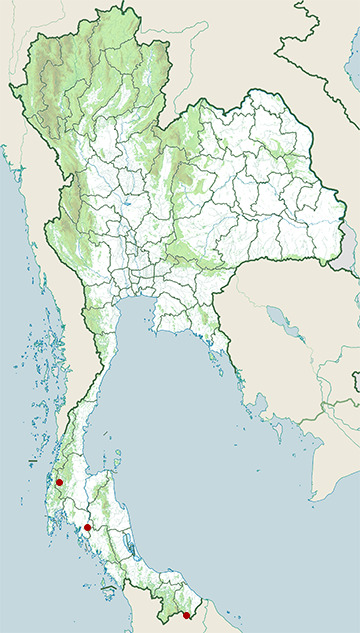Species of Thailand
Chestnut-capped thrush
Geokichla interpres
Coenraad Jacob Temminck, 1826
In Thai: นกเดินดงหัวน้ำตาลแดง
The chestnut-capped thrush (Geokichla interpres) lives in forests and woodlands of Southeast Asia. It is a songbird species in the family Turdidae. Traditionally, it has included the Enggano thrush as a subspecies, but a recent review recommended treating them as separate. Consequently, the chestnut-capped thrush is monotypic.
The chestnut-capped thrush has a black back and a white belly with black spots. As its common name suggests, it has a chestnut cap. Its face is black with a white mark on the cheeks and another on the lores. The superficially similar chestnut-backed thrush is substantially larger when seen alongside one another, and has a black crown and rufous back, whereas the Enggano thrush has an olive-ochre back and little or no white on the lores and auriculars.
The chestnut-capped thrush is very rare in zoos. According to ISIS, Chester Zoo had the only female outside of Asia, until she died in 2007. However, small numbers have been held in private European aviaries since the mid-1990s and very small numbers remain as of late 2009.
It was formerly classified as a species of Least Concern by the IUCN. New research has shown it to be rarer than previously believed. Consequently, it was uplisted to Near Threatened status in 2008.
This article uses material from Wikipedia released under the Creative Commons Attribution-Share-Alike Licence 3.0. Eventual photos shown in this page may or may not be from Wikipedia, please see the license details for photos in photo by-lines.
Category / Seasonal Status
Wiki listed status (concerning Thai population): Rare
BCST Category: Recorded in an apparently wild state within the last 50 years
BCST Seasonal status: Resident or presumed resident
Scientific classification
- Kingdom
- Animalia
- Phylum
- Chordata
- Class
- Aves
- Order
- Passeriformes
- Family
- Turdidae
- Genus
- Geokichla
- Species
- Geokichla interpres
Common names
- Thai: นกเดินดงหัวน้ำตาลแดง
Synonyms
- Zoothera interpres
Conservation status

Near Threatened (IUCN3.1)

Near Threatened (BirdLife)

Endangered (ONEP)

Endangered (BCST)
Photos

Range Map

- Hala-Bala Wildlife Sanctuary
- Khao Phra - Bang Khram Wildlife Sanctuary
- Khao Sok National Park